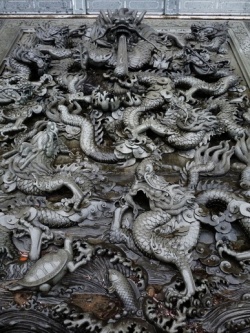Nagas and Dragons
Nagas are snake-like creatures that appear in the Pali Canon. They are sometimes identified as Dragons, but they have a slightly different origin.
Naga is the Sanskrit word for cobra. In ancient Indian Art, Nagas are depicted as human from the waist up and snakes from the waist down. They also sometimes appear as giant cobras. In some Hindu and Buddhist literature they can change appearance from human to snake.
In The Mahabharata, a Hindu epic poem, Nagas are depicted as mostly villainous creatures bent on harming others. In the poem, the enemy of Nagas is the great eagle-king Garuda.
In the Pali Canon Nagas are treated more sympathetically, but they remain eternally at War with garudas, except for a brief truce negotiated by the Buddha. In time, Nagas came to be depicted as guardians of Mount Meru and also of the Buddha. Nagas play an important role in Mahayana mythology as Protectors of the Sutras. You may find pictures of The Buddha or other sages sitting under the canopy of a great cobra's hood; this would be a Naga.
As Buddhism spread through China and on to Japan and Korea, Nagas came to be identified as a kind of dragon. Some stories told in China and Japan about Dragons originated as stories about Nagas.
In Tibetan Buddhist mythology, however, Dragons and Nagas are distinctively different creatures. In Tibet, Nagas usually are nasty water-dwelling spirits that cause disease and misfortune. But Tibetan Dragons are Protectors of Buddhism whose thunderous voices awaken us from Delusion.
